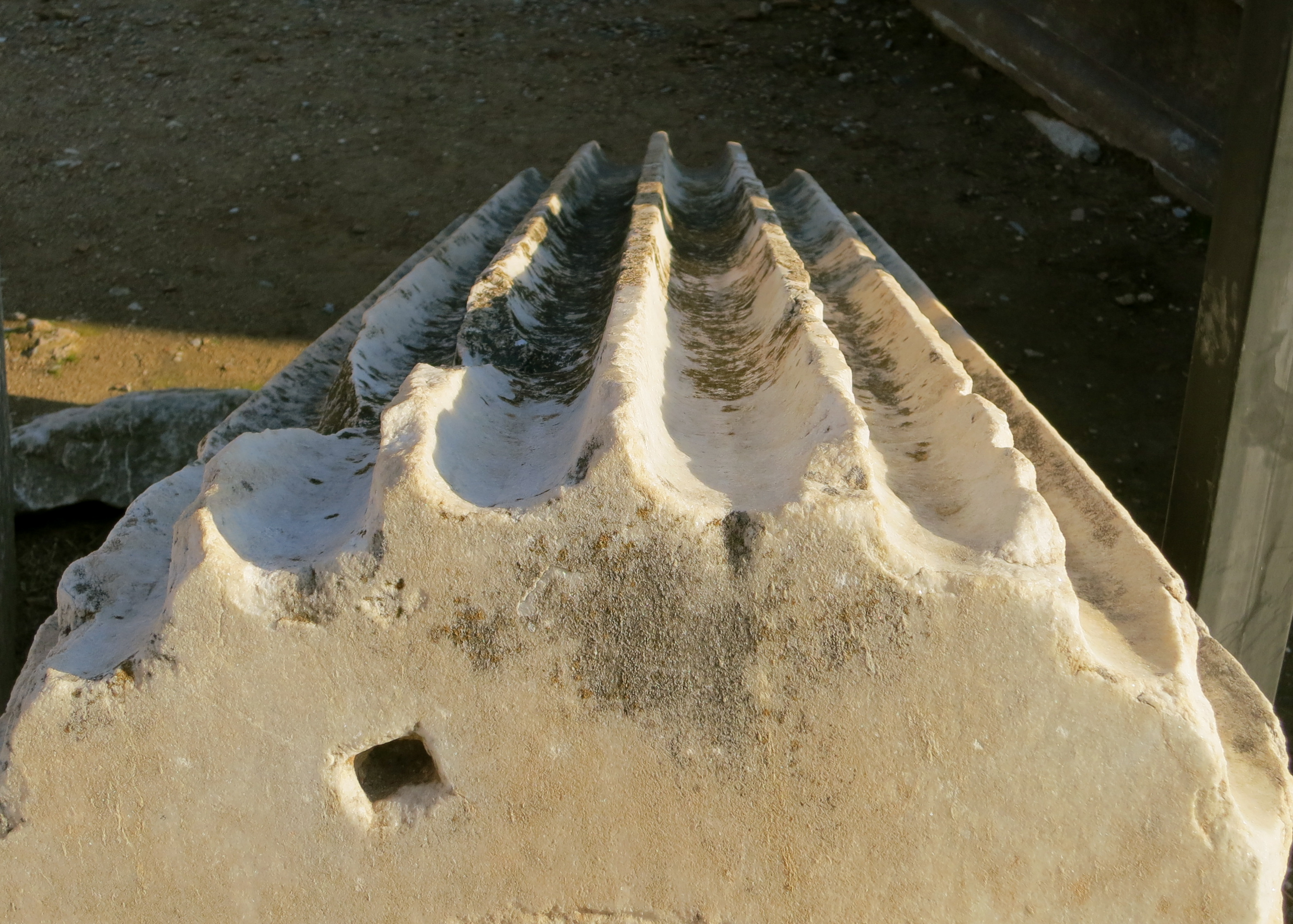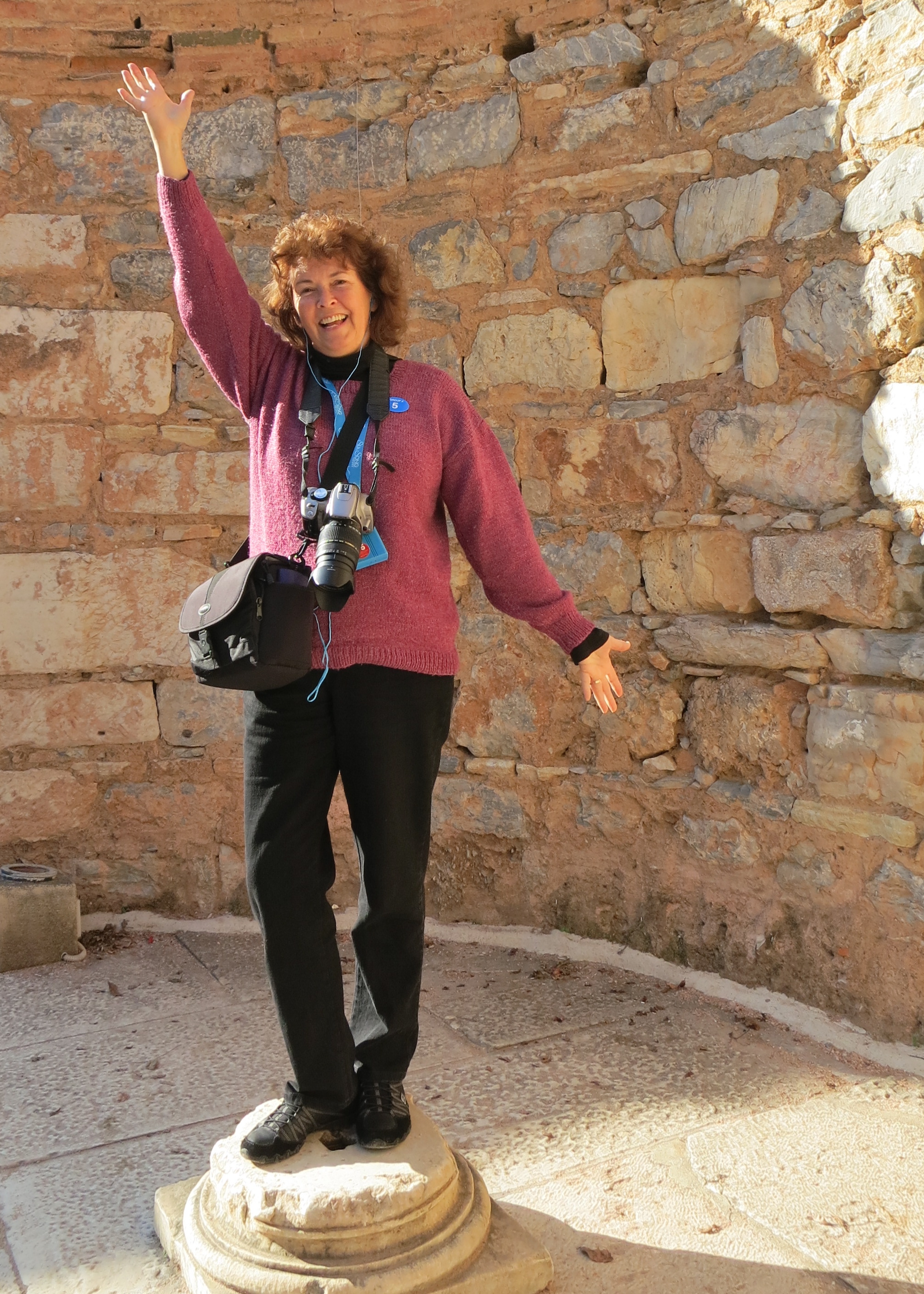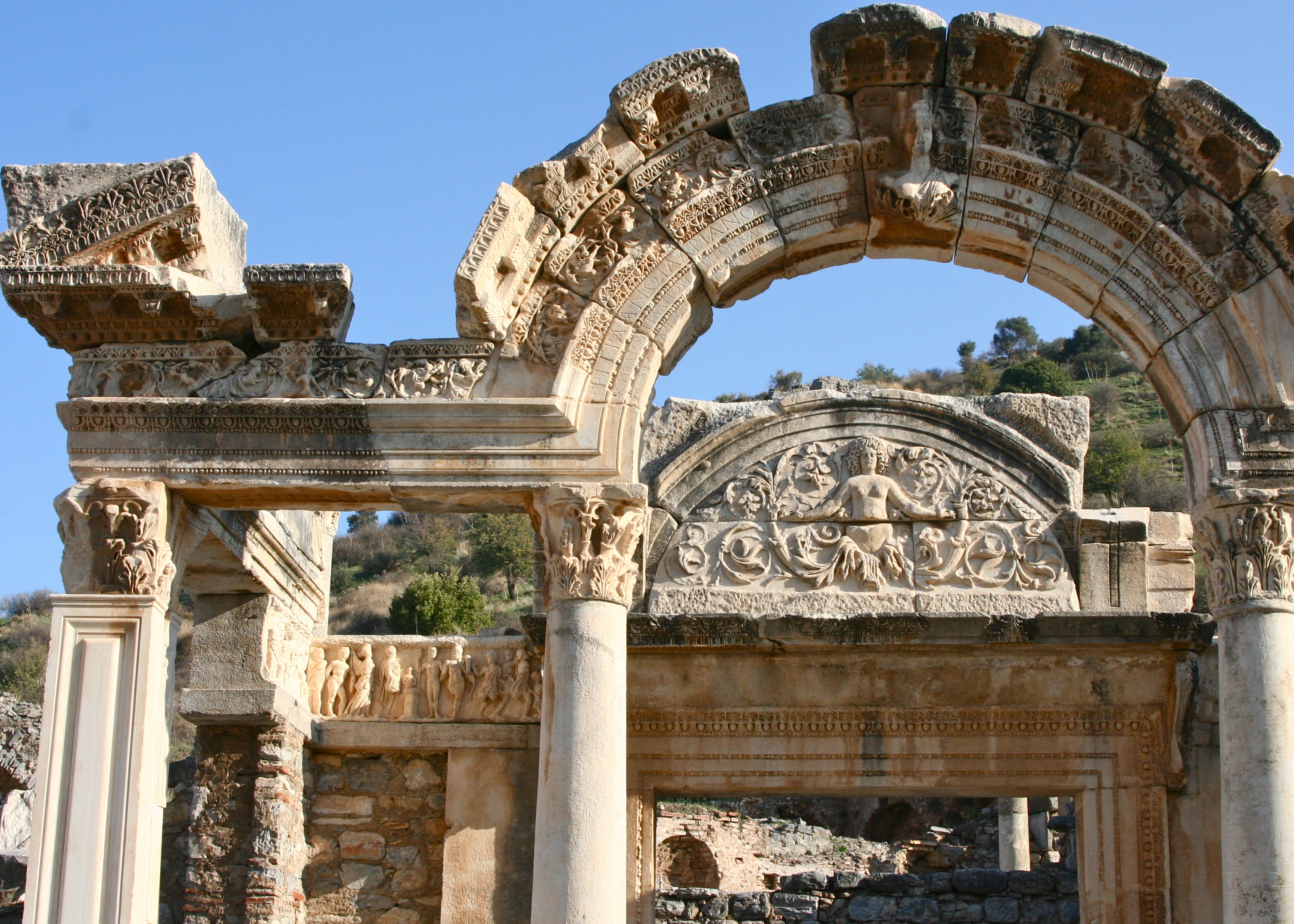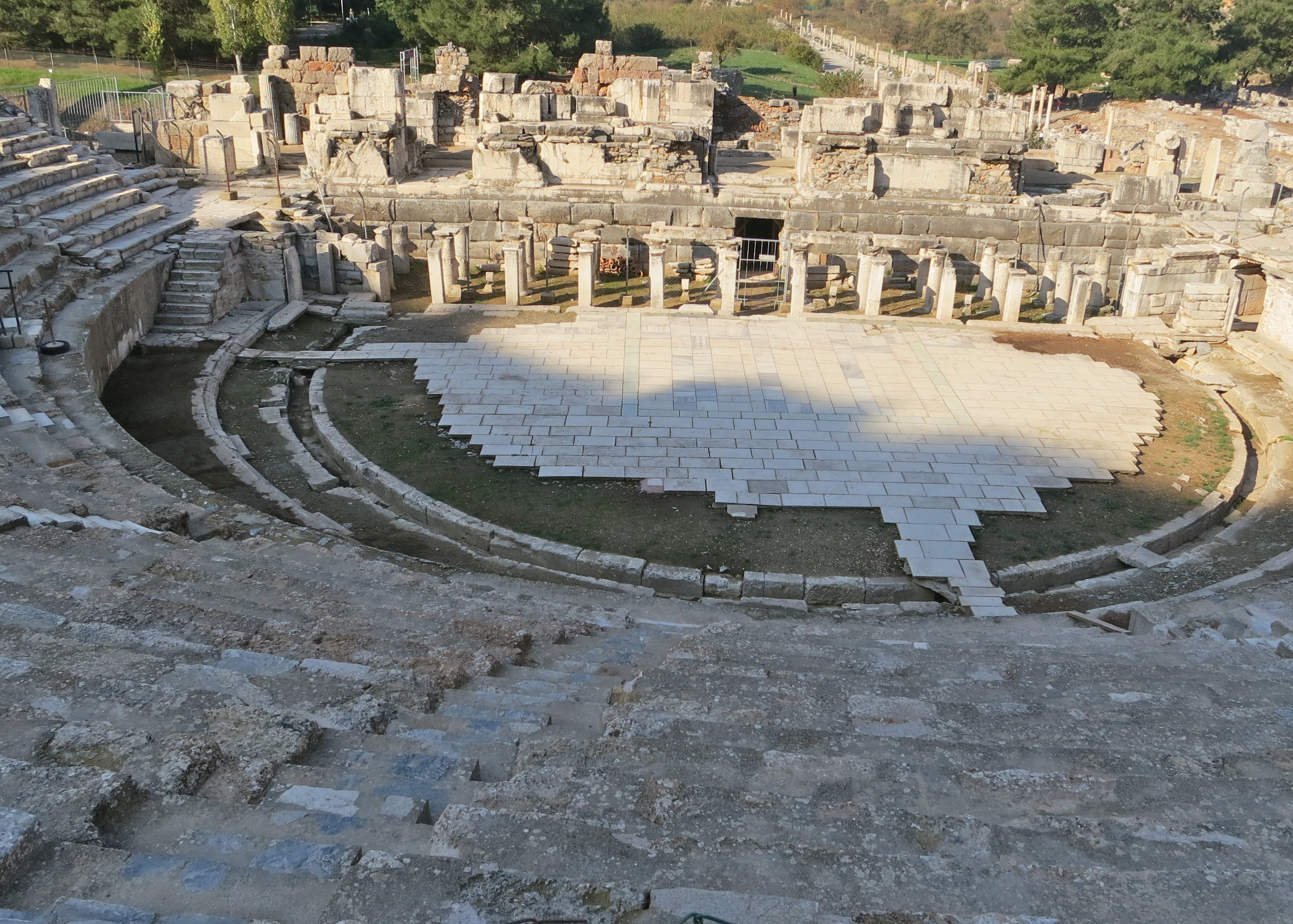I am adding to my armchair travel series today as Peggy and I continue to shelter at home hiding out from Covid-19. For today’s post I went traveling back in time through my blog archives and landed in the ancient Graeco-Roman of Ephesus, Turkey. It is located across the Aegean Sea from Athens. Peggy and I traveled there in 2013 along with her brother John Dallen, his wife Frances, and their/our friends Lee and Kathy Saage.

Artemis, The Greek Goddess of the hunt, chastity, virginity and fertility was big in Ephesus. (Somehow, being the Goddess of chastity and virginity— while also being the Goddess of Fertility— doesn’t compute.) Her temple, built in the sixth century BC, was considered one of the Seven Wonders of the Ancient World. Each May, the local Greeks would honor her with a Festival of Roses, which brings Mother’s Day to mind. As part of the festival they would sacrifice a number of bulls to encourage fertility. Modern time Mother’s Day has dropped this part of the ceremony.

Artemis is only a part of the Ephesus’ family of powerful women. Before the Greek Goddess Artemis became top female in the area, the Hittite mother-goddess Kubaba and the Anatolian goddess Cybele had reigned supreme. Amazons, the large warrior women who thought of men mainly as a source for making baby girls, were also known to frequent the region.
Following Artemis, the Virgin Mary was reputed to have spent her last days in Ephesus. A German mystic dreamed it and there is some historical support. Various modern Catholic Popes have backed up the supposition and Pope John Paul II declared the site where she supposedly died to be a shrine for Christian pilgrimages. Muslims, who call her Mother Mary, also make pilgrimages to the area. It stands on a hill above Ephesus.
Ephesus is located on the western coast of modern-day Turkey. We took a tour bus out to the site with a very talkative tour guide who shared with us that Santa Claus originated in Turkey, as well as a number of facts about Ephesus. The city had been an important part of Ionian Greece and included such luminaries as the Greek philosopher Heraclitus. In case you’ve forgotten your philosophers, Heraclitus, whose nickname was the Obscure, claimed that only change is permanent. “You never step in the same river twice,” he said.
This was certainly true of the Meander River. Ephesus was located on its banks and the curvy waterway kept moving to new locations, forcing Ephesus to move. And yes, the Meander River happens to be where our word meander comes from. I am rather fond of meandering.
It was the Romans who brought Ephesus to its height around 100 AD with a population of over 250,000, making Ephesus the second largest city in the Roman Empire. Most of the ruins featured below came from that period.













NEXT BLOG: Since we are in Turkey, my next post will explore the city of Kusadasi, where Peggy lusts after a Turkish rug and her brother buys two.
Cats always bring out the best in ruins. Watch out Peggy, remember the saying ‘Put me not on a pedestal lest I be denied the humility that is yours’… 😀
Of course they do, AC. I wonder if that is why they always seem to be found among ruins in Europe. Laughing… Peggy really isn’t a pedestal type person. Put her in a garden. and she is up to her elbows in dirt in no time. Put a backpack on her and up the mountain she goes. This didn’t mean she doesn’t like a bit of spoiling. Or more. 🙂 –Curt
Wonderful cat image!
Ephesus was Alie’s favorite stop on our Greek isle cruise.
I found both its history and its art fascinating, Ray. And the cat was frosting on the cake. 🙂 –Curt
Ephesus is one of my favourite destinations. Love the cat.
Have to agree, Peggy. And have you seen any ruins in Europe that didn’t come with cats? 🙂 Maybe they are the spirits of the ancients. (grin)
Ephesus is amazing isn’t it. Don and I did a road tour in turkey so drove ourselves there. You got some great shots Curt. Love the one looking upwards in the library.
Alison
Thanks, Alison. Fascinating between the Greek and Roman and even earlier history. And being a great fan of books, I fell in love with the Library of Celsus! 🙂 –Curt
My Greek grandparents immigrated from Smyrna (now Izmir) in the early 1900s…I believe these ruins sit in the countryside outside their city
And you are right! Ephesus is in Izmir Province.
Beautiful images, and I am also very partial to meandering! 🙂
Thanks, Sylvia. I could have named my blog Meandering through time and place. 🙂
I’ve learned something from this post and then some. But I really appreciate the photos. I’m also glad we don’t sacrifice bulls to celebrate Mother’s Day, but that’s another story. The columns fascinate me — as they did in Rome, Athens, etc. And those acoustics — everywhere we’ve seen an arena such as this one we’ve been amazed at how voices carry beautifully! Great post!
Thanks, Rusha. Peggy and I also found Ephesus very interesting and impressive. We were part of a tour but we broke free for a while when we found ruins that we felt deserved more time while keeping an eye on the group so it wouldn’t leave without us. Not sure the tour guide appreciated our independence. 🙂 We did the same thing at Pompeii. –Curt
Oh, you rebels. We’ve done the same thing! I love tours for the info, but sometimes, I just like to be on my own. Ephesus sounds like a place to explore!
Laughing. We normally prefer to go on our own. But there are times when a tour is the only way to get where we want to go. And I don’t mean to put down tours. We’ve been on some very good ones with excellent tour guides. –Curt
We have loved most of our tours and learned soooo much.
🙂
I loved Ephesus! It’s so fun to revisit it through your photos! Turkey is a country I would love to return to. Thanks for the armchair travel, Curt!
My pleasure, Kelly. Peggy and I are having a great time as well as we revisit some of our favorite places we have visited for our shelter in place posts. Judging from your posts, I would say you are having a similar experience! Thanks. –Curt
You and Peggy have been busy experiencing the world. I do love this post and
wish I could give a comment that reflected this. There are so much to re-learn about Greek mythology. You came across some powerful women there 🙂 .
Artemis with the dual personality, goddesses might get away with it.
Medusa now, you better look away…
Peggy makes a happy and beautiful goddess.
Keep travelling in the armchair for a while.
Miriam
Your comments are great, Miriam! Powerful women is right! And I will pass your comments on to Peggy. 🙂 –Curt
Great photos. The visiting sailors must have been so grateful to be pointed towards the brothels. I remember at Pompeii seeing a mural showing a seductive woman holding up a set of scales whereby the fee charged by the madam would be in direct proportion (and in gold) to the weight of the phallus resting on the scale.
Amazing!
The Ancients appear to have been much more open about sex than we are, Gerard. Peggy and I also traveled to Pompeii. I’ll include a photo or two of the brothel there. –Curt
Thanks for the memory nudge Curt. Great picture of you two at the end.
Had my own memory banks going, Andrew. Thanks. –Curt
Beautiful photos — much better than the ones my mom and I took when there in 1992. It is an amazing sight. Regarding the loo, we were told by our tour guide that it was unisex. 😳
Would be interesting. Hmmm. Or maybe not. 🙂 Our guide told us that musicians played there daily to mask the noise! Thanks, Gail. –Curt
I wonder how much of today’s creations will still be around 2500 years from now? (If humankind survives that long…) Great set of pictures.
Imagine coming on the Statue of Liberty… Where was that? In Planet of the Apes? I suspect everything now will be razed several times over. 🙂
This is really helpful and I have learned a great deal.
Thanks for commenting! It is a fascinating place. –Curt
Yeah, it is
This was a great refresher history for me after a trip to Ephesus in 2005 with our kids and my parents. I had been feeling a little “ruined-out” by the time we got to Turkey, but this place knocked my socks off, especially the library and the walkway to it. I laughed out loud at your comment about Artemis!
Greek and Roman ruins can start to look alike after a while Lexi. 🙂 As for Artimis, I left out the detailed description about bull’s anatomy. All the more reason not to hug her! –Curt